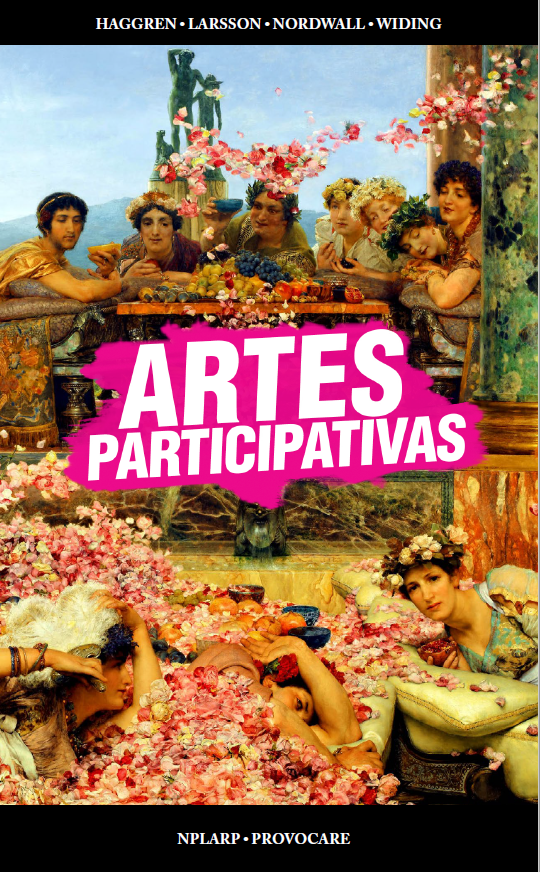Category: Interacting Arts
-

Artes Participativas
A Portuguese/Brazilian translation of Deltagarkultur has dropped in the shape of Artes Participativas. Thank you Tadeu Rodrigues Iuama for translating it and to Luiz Falcão for a proper re-enactment of the original shape and form. It is published by NpLarp and Editora Provocare. The book was written 2008 by Kristoffer Haggren, Elge Larsson and Andrea…
-
Byrån och agenten – enkelt verklighetsspel
Scenariot testades på lekklubben i Malmö. Det baseras lite på en avatarövning som jag och Ebba Petrén ägnat oss åt. Det här skrev jag fram under en varm eftermiddag tillsammans med Thom Kiraly och Petter Karlsson. ”Byråns kärnvärden är nyfikenhet, kamratskap, integritet och informationsfrihet. Är det förstått?” Förberedelser Spelet är gjort för en park. Vi…
-
Om verklighetsspel på lekklubben
Föreläsning, MALMÖ 20 juli 2013 Först och främst vill jag tacka Tora och Erik för att de bjudit in mig hit till Lekklubben för att leka tillsammans med er. Jag jobbar inom ramen för två konstkollektiv. Å ena sidan Interacting Arts, som sysslat mycket med rollspel och experimentella sociala praktiker. Å andra sidan Nyxxx, ett…
-
Lekklubben i Malmö – Bl a med verklighetsspel
Lekklubben är en plats där människor träffas för att leka tillsammans. Lekklubben uppstod ur en känsla av att det behövs platser där människor kan umgås bortom jobb, intellekt, mingel och prestation. En plats och stund där kropp, trams, känsla, sinne, skratt och lekfullhet får styra. Vi vill utforska lek som något man gör för stundens…
-
The Labyrinth of Possibilities
translated from Swedish by Thom Kiraly. Illustration by Josefin Rasmusson. Published in States of Play (PDF) (ed. Juhana Pettersson, 2012) for the Knutpunkt/Solmukohta conference. Create a reality game for friends and family! Play and storytelling have disappeared from our lives. Adventure has been demoted to being played out on computer screens and pages in books.…
-
The Avatar Condition
An UngaTur performance piece in collaboration with Interacting Arts There is no audience. There are no actors. The Avatar Condition is something else. Discover who you become when someone else makes your decisions. The Avatar Condition is an invitation to being controlled. To act without having to make decisions. Through headphones, you are instructed to…
-
Circle of Scent
This is a simple score for an aesthetic experience tied to our smelling senses. It’s not site, but audience specific in the sense that the experience will differ depending on whom the participants are. The Circle of Scent is realized through a few simple steps: Organize a group of people in a circle, facing the…
-
Intervjuad i Märklighetstroget
Lyssna gärna på rollspelspodcasten Märklighetstroget! Den drivs av Thom Kiraly som varit inblandade i diverse märkliga projekt. I dagens avsnitt så pratar jag och Thom om Deltagarkultur, så det kanske inte är så mycket nytt för er som läst boken. Om två veckor kommer ett nytt avsnitt med lite mer lösa tankar, kanske mest om…
-
Om tunnelfolket i Hemliga städer
Glänta förlag och Göran Dahlberg släppte tidigare i år en bok om hemliga platser av olika slag. Jag var och lyssnade på releasen på Milliken gallery, men köpte aldrig boken. Hemliga städer är en essä om “flyktingläger, rymdbaser, atombyar och hemliga sällskap”. Axel Löfving uppmärksammade mig idag på en passage i kapitlet ‘Underjordiskt liv’ som…
-
Rapport från Samskrivande & rolltagande
Förra helgen körde vi jag och Ulf Staflund en workshop där vi försökte kombinera metoder från samskrivande och rollspel. Tre personer skrev och resten agerade eller tittade på. Vi hade förberett fem scenarion som med olika tema och struktur. I varje scenario såg relationen mellan text och spel olika ut. Målet var inte att skapa…